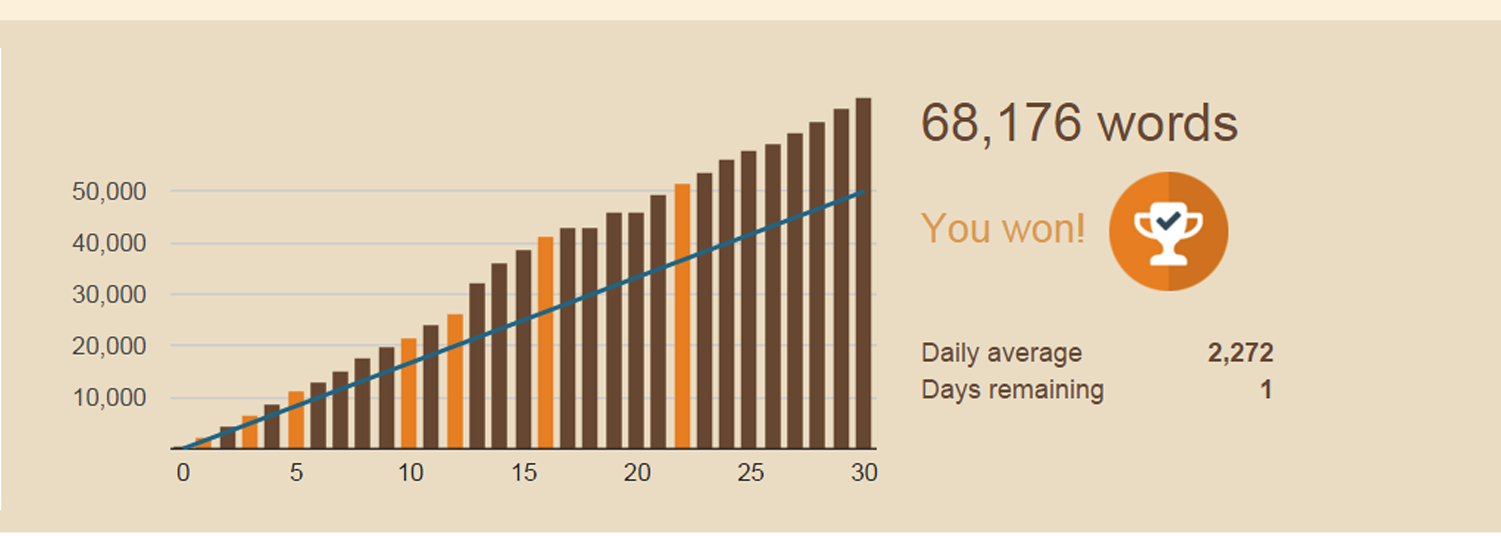Winner! Yay!
This year was my fourth time participating in NaNoWriMo, the National Novel Writing Month. While the challenge is always the same—produce 50,000 words during the 30 days of November—each experience is slightly different.
Same Strategy, Different Book
This year was a lot more like my first year than my previous two. Because I’d been working on other writing projects, I didn’t really get a chance to do a lot of planning. Consequently, I pantsed the sucker. Basically, I started on Day 1 with a single vivid scene in my mind. That turned into two chapters, which spawned seven or eight earlier chapters leading up to my original scene. The plot bunnies multiplied and pretty soon I had a whole story on my hands.
Unlike previous years, I never got stuck. Even now, on Day 31, I still have plenty of chapters racked up and ready to write. I never really had to squeeze … instead, I just had to show up in front of my keyboard so the words could come out.
As always, I didn’t get a chance to finish a whole book. My books are just longer than 50,000 words (or 68,000, which is what I ended up writing). I anticipate that this draft will end up at around 120K words, which I’ll try to tighten up to 110K.
Once again, I kept my strategy of leaving home to write. I just can’t produce as well at home. So almost every evening in November, I left home at around 9:00 or 9:30 and sat somewhere else as I typed until 11:00 or 12:00. I wrote in seven different fast food restaurants, three truck stops, two different libraries, a bar/grill and a hotel room. It works for me, so I’ll keep doing it. The workers at the 24-hour Love’s/Subway by my house all know my name.
Writing Weekend
I’ve always wanted to try taking a few days by myself to see whether I could really crank out some words. This year, I actually did it. I took off a Friday, and spent Thursday night, Friday night and Saturday in a hotel in Las Vegas (which is 2-1/2 hours away from my house). To win NaNo you have to produce 1,666 words per day, every day, for the entire month of November. My goal was 2,000 words—more when I had the time and stamina.
My wife was in San Diego that same weekend, so I knew she would be driving to Vegas Saturday afternoon or early evening. That gave me about 48 hours to produce as many words as I could. The only gambling I did the whole time was a game of Bingo after my wife showed up.
I bounced around a lot, and I used meals as my reward. I started at a bagel shop, produced 1,000 words there, moved back to my hotel room and wrote another thousand. Rewarded myself with lunch, then went to a library to crank out another grand. Moved to a McDonald’s and got a Diet Coke and wrote some more. Friday was my most productive day, with over 6,000 words. Saturday was a 4,500-word day. Add to that the 2,000 words I wrote on Thursday night and I produced over 12,500 words in under 48 hours. I’ll take that.
NaNoWriMo Young Writers Program
I don’t think I knew before this year, but NaNo has a Young Writers Program. This year I got to do something about it. A good friend of mine teaches creative writing at a local high school. I was privileged to have the opportunity to talk to four of his classes about NaNo and what it has to offer a young writer.
If you want to look at my presentation slides, you can do so here. And yes, apparently it’s okay to use the word “badassery” when talking to high school students.
Of the 12 students who added me as “writing buddies” four won the 50,000-word challenge. Others likely set smaller goals and met them. I’m proud of my writing buddies; it was great to follow their success throughout the month.
The Value of NaNoWriMo
A lot of people question the idea of forcing yourself to sit down every day and crank out a certain number of words. “That’s not the way art is produced!” “That’s counter-creative!” To that, I say bull-puckey.
Unlike other kinds of artists, a writer can’t got to a store and buy tubes of paints or a box of clay. A writer has to create his or her own raw materials before they can be turned into art. The goal of NaNo is to give yourself permission to create a big pile of words that can later be turned into something wonderful.
In order to be successful, a writer has to learn to disengage the internal critic that prevents production and exploration and discovery. When I talked to the young writers, I asked them to visualize a cartoon devil on their shoulde, sitting there saying, “That’s crap—nobody’s gonna want to read that! Watch your spelling and grammar and punctuation! Don’t move on until it’s perfect!” If you commit to NaNoWriMo, you have to learn to kick that devil off your shoulder and just produce, because you simply don’t have time to revise.
NaNo is about drafting, and drafting isn’t about art. Drafting is about work and work ethic. To a great degree, it’s about developing writerly habits. It’s about applying your butt to a chair and then applying (digital) words to (digital) paper. The art comes later, but it never will come if you don’t have a pile of words to start with.
So yay! I’ve got me a pile of words … about 60 percent of a full draft. Next step: finishing the draft, and then making art.
